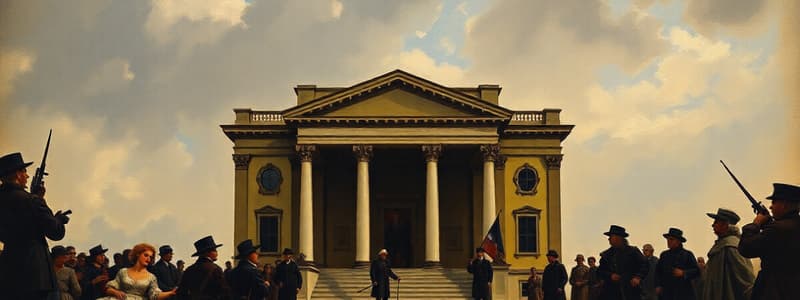Podcast
Questions and Answers
What principle ensures that no single branch of government becomes too powerful?
What principle ensures that no single branch of government becomes too powerful?
- Judicial Review
- Federalism
- Direct Democracy
- Separation of Powers (correct)
Which of the following is NOT one of the three branches of government established by the U.S. Constitution?
Which of the following is NOT one of the three branches of government established by the U.S. Constitution?
- Legislative
- Executive
- Judicial
- Administrative (correct)
What is the role of the Legislative Branch in the U.S. government?
What is the role of the Legislative Branch in the U.S. government?
- Enforcing laws
- Interpreting laws
- Making laws (correct)
- Vetoing laws
Which power allows the Supreme Court to declare laws unconstitutional?
Which power allows the Supreme Court to declare laws unconstitutional?
What is the primary purpose of the system of checks and balances?
What is the primary purpose of the system of checks and balances?
In what year was the U.S. Constitution ratified?
In what year was the U.S. Constitution ratified?
Which amendment to the Constitution guarantees freedom of speech?
Which amendment to the Constitution guarantees freedom of speech?
Which branch of government is responsible for enforcing laws?
Which branch of government is responsible for enforcing laws?
Flashcards
Federalism in the U.S. Constitution
Federalism in the U.S. Constitution
The U.S. Constitution divides power between the federal government and state governments, defining their specific roles and interactions.
What is the Bill of Rights?
What is the Bill of Rights?
The first 10 amendments to the U.S. Constitution, ratified in 1791, guarantee fundamental rights and liberties.
What is the separation of powers?
What is the separation of powers?
The U.S. Constitution established three branches of government—Legislative, Executive, and Judicial—each with unique powers and responsibilities.
What is the job of the Legislative Branch?
What is the job of the Legislative Branch?
Signup and view all the flashcards
What does the Executive Branch do?
What does the Executive Branch do?
Signup and view all the flashcards
What does the Judicial Branch do?
What does the Judicial Branch do?
Signup and view all the flashcards
How do the branches of the U.S. government check and balance each other?
How do the branches of the U.S. government check and balance each other?
Signup and view all the flashcards
Why did the framers design the separation of powers?
Why did the framers design the separation of powers?
Signup and view all the flashcards
Study Notes
Key Aspects of the U.S. Constitution (1788)
- Separation of Powers: The Constitution divides governmental authority among three branches: Legislative, Executive, and Judicial. This system of checks and balances prevents any single branch from becoming too powerful.
- Federalism: Distinct power-sharing arrangements exist between the federal government and state governments. This clearly demarcates the jurisdictions of each.
- Bill of Rights: The first ten amendments, although ratified later (1791), are integral to the Constitution. They safeguard fundamental rights and freedoms.
Separation of Powers: A Thorough Discussion
- Three Branches: The Constitution establishes the Legislative, Executive, and Judicial branches.
- Legislative (Congress): This branch, comprised of the Senate and House of Representatives, is responsible for lawmaking.
- Executive (President and Administration): The Executive Branch enforces the laws, led by the President as Commander-in-Chief and treaty negotiator.
- Judicial (Supreme Court and Other Courts): This branch interprets laws, including through judicial review, the authority to deem laws or actions unconstitutional.
- Checks and Balances: Each branch possesses means to limit the power of the others. For example, Congress can pass laws, but the President can veto them, while Congress can override the veto. The judicial branch can overturn laws deemed unconstitutional.
- Preventing Tyranny: The separation of powers structure emerged from the desire to avoid a concentration of unchecked authority, similar to British rule. This arrangement strives to balance governmental authority with individual liberties.
Studying That Suits You
Use AI to generate personalized quizzes and flashcards to suit your learning preferences.
Description
Explore the foundational principles of the U.S. Constitution, including the separation of powers, federalism, and the Bill of Rights. This quiz covers essential aspects that have shaped American governance and individual freedoms. Test your knowledge of these critical components!




